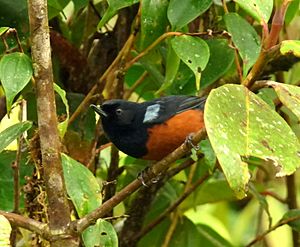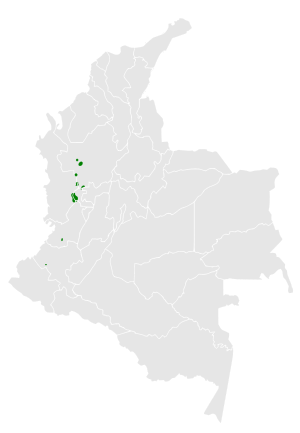Chestnut-bellied flowerpiercer facts for kids
Quick facts for kids Chestnut-bellied flowerpiercer |
|
|---|---|
 |
|
| Conservation status | |
| Scientific classification | |
| Genus: |
Diglossa
|
| Species: |
gloriosissima
|
 |
|
The chestnut-bellied flowerpiercer (its scientific name is Diglossa gloriosissima) is a small, beautiful bird. It belongs to the Thraupidae family, which includes many types of tanagers. This special bird lives only in Colombia, which means it is endemic there. You can find it in cool, moist montane forests and high-up shrublands in the mountains. Sadly, its home is shrinking, which puts this amazing bird at risk.
Contents
What is a Chestnut-bellied Flowerpiercer?
Meet the Flowerpiercer Family
Chestnut-bellied flowerpiercers are small birds that live in the mountains. They are part of a group called Diglossa, which means "double-tongued." This name comes from their special bills. Their slender, upturned bills are perfect for piercing the base of flowers. This allows them to reach the sweet nectar inside. They also eat small insects.
How Big Are They?
These birds are about 14 to 15 centimeters (about 5.5 to 6 inches) long. Their wingspan is around 7.5 cm (3 inches) for males and 7 cm (2.7 inches) for females.
What Do They Look Like?
Adult Males
Adult male chestnut-bellied flowerpiercers are mostly shiny black. Their head, upper chest, back, wings, and tail are a deep, glossy black color. They have a touch of bluish-grey on their shoulders and rump. The most striking part is their lower chest, belly, and bottom area, which are a rich, reddish-brown color. They have some black marks on their sides. Their bill is black, and their legs and feet are grey.
Adult Females
Female flowerpiercers look very similar to the males. The main difference is that their rump (the area just above the tail) shows more of that bluish-grey color.
Young Birds (Juveniles)
Young flowerpiercers look a bit like the adults, but their black feathers are not as shiny. Their shoulders and rump are black, not bluish-grey. The reddish-brown areas on their belly have black streaks. Also, the bottom part of their bill is yellow with a dark tip.
Where Do They Live?
Finding Their Home in Colombia
The chestnut-bellied flowerpiercer lives in only a few small, separate places in the high Western Andes mountains of Colombia. People have seen them in different areas, including the departments of Antioquia, Cauca, Chocó, and Risaralda.
Because many of these mountain areas are high up and hard to reach, it's possible that there are more groups of these birds waiting to be discovered!
Their Mountain Habitat
These flowerpiercers usually live at very high elevations, between 3,000 and 3,800 meters (about 9,800 to 12,500 feet). However, in one spot called Cerro Montezuma, they can be found as low as 2,400 meters (about 7,900 feet).
Their favorite places to live are open páramo (a type of high-altitude grassland), shrubby areas just below the páramo, and the edges of "elfin forests." Elfin forests are dense, stunted forests found at high elevations. They especially like forests with Polylepis trees, which are small trees that grow in the Andes. They also like other small trees like Escallonia and Baccharis.
How Do They Live?
Studying a Shy Bird
For a long time, not much was known about the chestnut-bellied flowerpiercer. This was because their mountain homes were very remote. There were no sightings of this bird between 1965 and 2003! Because of this, we still don't know a lot about their daily lives.
When Do They Have Babies?
Scientists have found signs that these birds reproduce in February and August. This includes finding females ready to lay eggs and seeing nests being built.
What Do They Eat?
These birds are known to feed on nectar from various flowers. They especially like flowers from the Melastomataceae and Ericaceae families, including plants like Cavendishia, Psammisia, and Thibaudia. They also visit Loranthaceae plants and epiphytic bromeliads (plants that grow on other plants). Like other flowerpiercers, they also hunt for small insects. Interestingly, at one location, they have even been seen visiting hummingbird feeders!
Their Behavior
The chestnut-bellied flowerpiercer is a territorial bird. This means they defend their living space. They usually form pairs only when they are nesting. However, they have been seen moving around in small family groups of up to five birds. They also sometimes join mixed flocks with other bird species. In one area, chestnut-bellied flowerpiercers and black-throated flowerpiercers (a similar species) have their own separate territories.
Why Are They at Risk?
Their Status
The IUCN (International Union for Conservation of Nature) lists the chestnut-bellied flowerpiercer as Near Threatened. This means they are close to becoming endangered. The Colombian Red Book of Birds says the bird is Vulnerable. This is because their homes are very spread out and getting smaller or less healthy. Their total population is also small, probably less than 10,000 adult birds.
Main Dangers to Their Home
The biggest threats to the páramo and elfin forest habitats are:
- Livestock grazing: Animals like cows eating too much of the plants.
- Fires: Fires started by tourists or to clear land for cattle.
- Growing human settlements: More people moving into these areas.
- Deforestation: Trees being cut down.
- Agriculture: Farming activities.
- Uncontrolled tourism and hunting: Too many visitors or hunting without rules.
- Mining: Digging for minerals.
The Polylepis forests, which are very important for these birds, are especially at risk from logging and too much grazing.
Helping Them Survive
Good news! Many of the places where these flowerpiercers live are now protected areas. This makes it easier to create plans to help them. Some of these protected areas include:
- Paramillo National Natural Park
- Tatamá National Natural Park
- Munchique National Nature Park
- Farallones del Citará and Mesenia-Paramillo forestry reserves
They are also found in bird reserves like Fundación ProAves Las Tangaras and Colibrí del Sol Natural Bird Reserves. Local groups have also set up protected areas where the bird has been seen.
There's also a project focused on protecting the Polylepis forests, which are key to the flowerpiercer's survival. This project helps different countries in the Andes work together to save these special ecosystems.
Images for kids
See also
 In Spanish: Pinchaflor ventrirrufo para niños
In Spanish: Pinchaflor ventrirrufo para niños



